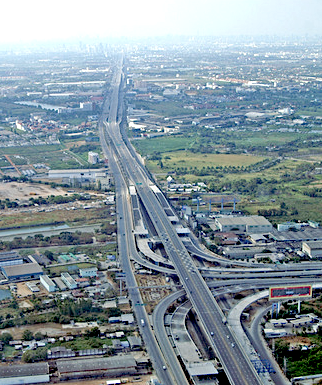
Thailand's Development Plan Keys Infrastructure Links
Aside from these, the roads planned for Thailand are: - Thailand will build another highway
apart from Phahon Yothin Road.
- A road link from Mukdahan to the Eastern Seaboard - The transport route for Thai entrepreneurs using Laos as a production base Rail links planned for Thailand are: - From Chiang Rai and Chiang Mai has
also been discussed
- Along with perennial talk of a high-speed train between Chiang Mai and Bangkok He also said that Thailand needs to expand the capacity of Suvarnabhumi Airport, Laem Chabang Port, new motorways, the Outer Ring Road and even build a high-speed train link between the main economic provinces. 10-year Plan: The 10-year plan focuses on development in Kanchanaburi, Chachoengsao, Prachin Buri and Nakhon Ratchasima provinces, while Nakhon Nayok is slated for an education city. He expects infrastructure development in major cities will open up new economic areas in Nakhon Ratchasima and Kanchanaburi as new industrial and service bases after the development of the Dawei deep-sea port and industrial estate in Myanmar. 5-year Plan: The five-year plan covers 95 projects with a 2.27-trillion-baht budget for roads and railroads, and was endorsed by the cabinet. Mr Arkhom said Thailand also needs to plan for appropriate industries for the next five, 10 and 20 years. He noted agriculture and agri-business need to upgrade production technology to produce more ready-to-eat products. Green industries such as bio-plastics and renewables are also certain to be popular. He called for more technology in the petrochemical, automotive, and electronics and electrical product industries, as well as more research and development centres in Thailand. New Industrial Parks to support the infrastructure - Four new industrial estates are
planned along the borders. The plan supports the East-West Economic
Corridor development, which aims to link China's southern provinces
with its neighbors in the lower Mekong region. The Industrial Estate
Authority of Thailand (IEAT) plans to develop four industrial parks
along the borders to help promote trade and investment. Construction
will begin this year and the new estates should be ready to begin
operation within 2015, when the Asean Economic Community (AEC) is
formed.
- In northern Thailand, to support the project aims to link China's southern cities with Southeast Asia, IEAT is seeking a strategic partnership with the private sector for the development of the Chiang Kong industrial estate near the Golden Triangle in Chiang Rai. This project would focus mainly on agriculture, medicine, electronics and logistic services. - In the Northeast, the Khon Kaen governor has sought to build an industrial estate there, with the feasibility study being conducted by Khon Kaen University. The project, aimed at linking trade between Thailand and Indochina, was preliminarily planned to be an eco-friendly industrial estate. - Another potential project would be in Tak province's Mae Sot district, primarily to cater to the textile and garment industry. The project will serve labour-intensive sectors and is expected to begin operation within 2015, reported the paper. Between Neighboring Countries: Vietnam, Laos and Thailand agreed to
boost geo-economic axis co-operation during a meeting held in the
central province of Kon Tum just recently, reported Vietnam News. The
axis includes the central provinces of Kon Tum, Quang Ngai and Binh
Dinh of Viet Nam, Ubon Ratchathani and Sisaket of Thailand, and
Champasak, Salavan, Sekong and Attapeu of Laos.
Ubon Ratchathani enjoys advantages in agriculture and tourism while Sisaket is famous for its rubber and rice. Lao’s Champasak, Sekong and Atapeu provinces are abundant in energy, tourism and mineral plants. Vietnam’s Binh Dinh Province has potential to develop marine tourism while Quang Ngai is well-known for its Dung Quat Economic Zone. Kon Tum itself is a haven for eco-tourism. Based on individual specialties, provincial authorities agreed to co-operate in the fields of tourism, rubber and coffee cultivation, agricultural facility production, energy and power projects, mineral exploration and forest conservation. Agreement was also reached on raising funds to invest in infrastructure upgrades, such as the expansion of the 50km route between the Bo Y border gate and Attapeu. Provinces would also implement measures towards human resource training and exchange, setting up information centres serving trade, tourism and investment activities. In addition, Da Nang University’s branch in Kon Tum is set to sign a co-operation deal with Thailand’s Ubon Ratchathani Rajabhat University while enterprises participate in another meeting on investment opportunities at the Bo Y International Border Gate Economic Zone. About the Author: Christopher W. Runckel, a former senior US diplomat who served in many counties in Asia, is a graduate of the University of Oregon and Lewis and Clark Law School. He served as Deputy General Counsel of President Gerald Ford’s Presidential Clemency Board. Mr. Runckel is the principal and founder of Runckel & Associates, a Portland, Oregon based consulting company that assists businesses expand business opportunities in Asia. (www.business-in-asia.com) Until April of 1999, Mr. Runckel was Minister-Counselor of the US Embassy in Beijing, China. Mr. Runckel lived and worked in Thailand for over six years. He was the first permanently assigned U.S. diplomat to return to Vietnam after the Vietnam War. In 1997, he was awarded the U.S. Department of States highest award for service, the Distinguished Honor Award, for his contribution to improving U.S.-Vietnam relations. |

